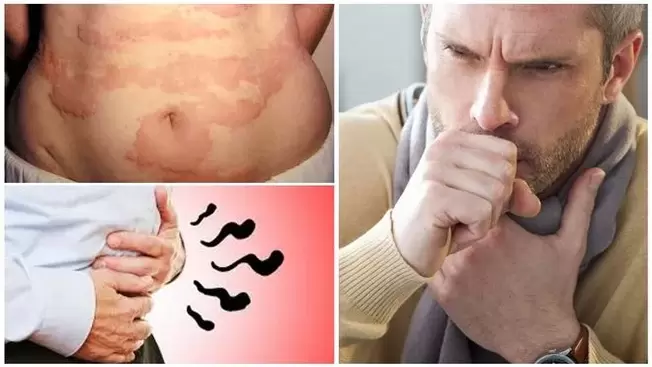Personal hygiene has improved significantly over the past century, but the problem of worms is still relevant not only for rural residents, but also for city dwellers. Statistics make it clear how high the risk of helminth invasion is: every third person on earth suffers from helminthiasis. But this disease does not always manifest itself clearly, and in some cases the sick cannot correctly interpret the symptoms and remain in the dark for a long time without taking any action. Questions about how to understand that you have worms arise both with helminthiasis and with other pathologies with similar symptoms.

Worms are an extensive group of parasitic worms, the main characteristics of which are similar in the human body. Doctors believe that every person has been exposed to helminthiasis at least once in his life. In addition, the presence of helminths in the body can provoke the development of other diseases, sometimes very dangerous, so the question of diagnosing this disease is very important.
mechanisms of infection
Infection with worms occurs in four main ways:
- water, earth or sand. Soil and water provide ideal conditions for storing parasite eggs. A person bathing in open water always runs the risk of swallowing eggs, which subsequently turn into adults. Not as rarely as it might seem, humans also swallow particles of earth and thus expose themselves to the risk of infection. Certain types of parasites can enter the body directly through the skin.
- Meal.Worm eggs can be found on the skins of fruits and vegetables that have not been washed or cooked properly. Eating raw or lightly processed meat, dried fish, dairy products, etc. comes with no fewer risks.
- contact with the patient. Direct contact can be both with a sick person and with an infected animal. Joint activities, living in a common area and close communication contribute to the rapid penetration of parasites into the intestine and its further development.
- bites.Worms can be transmitted through insect bites. This is one of the rarest routes of infection in temperate latitudes, but sometimes it becomes the cause of the disease. In hot countries, this way is more common, which should be remembered when vacationing in warm countries.
symptoms
Those who want to know how to understand that you have worms should understand the principles of recognizing symptoms. Any symptoms of helminthiasis do not appear immediately after infection, but only when the parasite stops migrating through the gastrointestinal tract and begins to develop into an adult.
Some of the signs are due to the ingestion of toxins that the worm releases throughout its life. All wastes enter the intestinal lumen, from where they are absorbed into the bloodstream and transported to all organs. Usually there are more signs and they are stronger in the condition of multiple infection, when the number of worms becomes significant. In people with immunosuppression or other chronic diseases, symptoms worsen over a relatively short period of time.

All signs are divided into two large groups: explicit and hidden. Explicit ones can be assessed independently at home, while hidden ones can only be detected in an outpatient setting with the help of appointments for certain tests and examinations.
explicit
The obvious ones include symptoms by which it can be understood that worms are present in the body. Their presence does not cause symptoms that are too obvious, as is the case, for example, with the development of viruses. Parasites target life inside the body, so too much deterioration in the infected host's condition would pose a threat to their life. Because of this, the symptoms do not require emergency treatment.
You can suspect or understand the presence of a helminthic invasion by the following signs:
- Gradual weight loss for no apparent reason lasting several months and sometimes several years at a time. The rate of weight loss is not catastrophic, most often they are 2-5% per month. With a high intensity of infection in people with reduced immunity, this figure can reach up to 10%.
- Diseases of the gastrointestinal tract. Some worms can block the bile ducts or intestinal lumen, resulting in a stable blockage. On the other hand, if the intensity of the release of toxins is high, recurring diarrhea can occur. Due to inflammation of the walls of the upper part of the small intestine, increased flatulence and gas formation are often observed, and flatulence is possible.
- Severe pain in the joints and muscles. Often such manifestations are attributed to the development of arthrosis, but in the case of helminths, this is caused by the migration of parasites. In addition, such pain can be due to the influence of toxins on the joints and muscle tissue.
- itching near the anus. This phenomenon is caused by the fact that a large number of species of parasitic worms crawl out of the lumen of the rectum to reproduce and lay eggs. This causes severe itching, which intensifies in the evening and at night.
- allergic manifestations. Often occurs in response to the appearance of a large number of toxins in the blood or due to damage to the intestinal mucosa, causing an increase in the immune system and an allergic reaction.
- Pulmonary manifestations. Possible in a wide spectrum, ranging from constant coughing to pneumonia. Characteristic of intense ascariasis, which occurs in a period of at least three months from the moment of infection.
- High temperature. Such a manifestation can be of varying intensity. Most often, a low temperature of about 37 °C persists around the clock, but fever can be observed in rare cases.

Hidden
Hidden signs can only be uncovered by a doctor who can adequately assess the condition and understand that worms may be the likely cause. Preventive measures for diagnosing worm diseases are:
- Fecal analysis for worms. It has to be submitted in two steps, so experts do not consider the results of an analysis to be reliable. This is due to the cyclicity of reproduction, so it is far from always possible to understand from an analysis of feces that the patient suffers from helminths.
- Clinical blood test. Elevated levels of eosinophils indicate that parasites are likely present in the body. Often such an assumption arises after tests during the treatment or diagnosis of other diseases.
- antibody analysis. At the moment it is one of the most reliable diagnostic methods that will help to understand whether a person has worms. Although it is more expensive than comparable drugs, it has recently been prescribed more and more by doctors because of its high information content and reliability.

Antiparasitic drugs or laxatives should not be taken prior to clinical testing for parasites, as this complicates diagnosis.
signs in a child
In children, the presence of worms is diagnosed more often than in adults. This is favored by poor hygiene, close contact with domestic or street animals and an incomplete development of the immune system. A growing organism usually reacts more acutely to the presence of parasites, and the consequences can be more global than in adults. But to understand that a child has worms is not very easy. Symptoms can be the same as in adults but are usually more acute.
In most cases, signs indicating helminthic invasion in children are :
- Rapid weight loss. With a running picture, such a manifestation can cause a delay in physical development;
- Deterioration of hair and nails. It occurs due to a long-term lack of nutrients and vitamins caused by a violation of the absorption of digested food in the intestine.
- sleep disturbanceThe pathology can cause the child to wake up more often at night, cry, turn over and talk in a dream.
- Irritability. Intoxication of the nervous system and poor health can affect the emotional state of the child, lead to increased excitability, capriciousness, tearfulness, etc.
- The desire to constantly scratch the anus. Children do not control external manifestations, so this symptom often helps to understand the cause of ailments and physical changes.

Some parents tend to give their children broad-spectrum antiparasitic drugs for prevention, but experts do not recommend this as most of these drugs are quite difficult to tolerate. It is better to first understand whether the child is infected and what kind of treatment he needs, since therapy for different types of worms is significantly different and is not always effective with helminths of other groups.








































